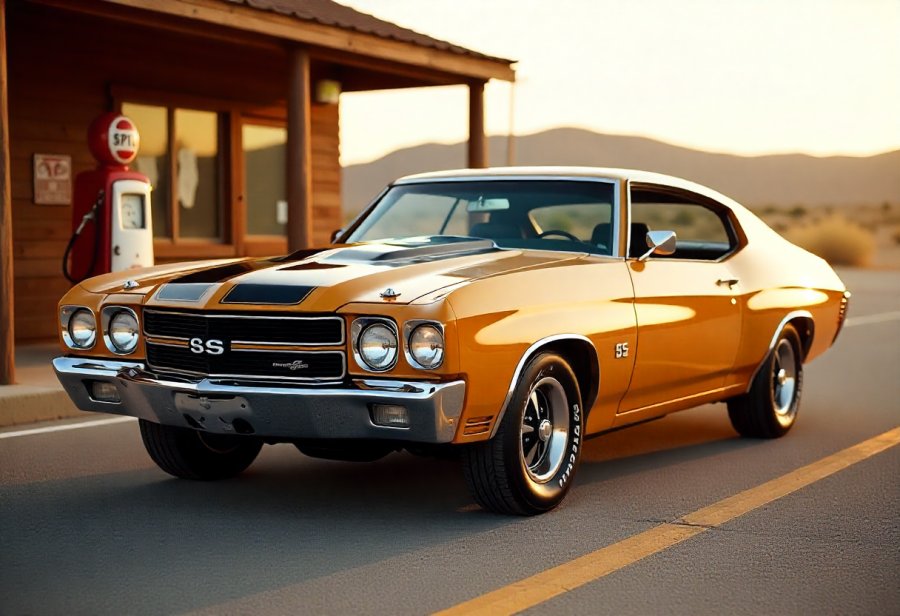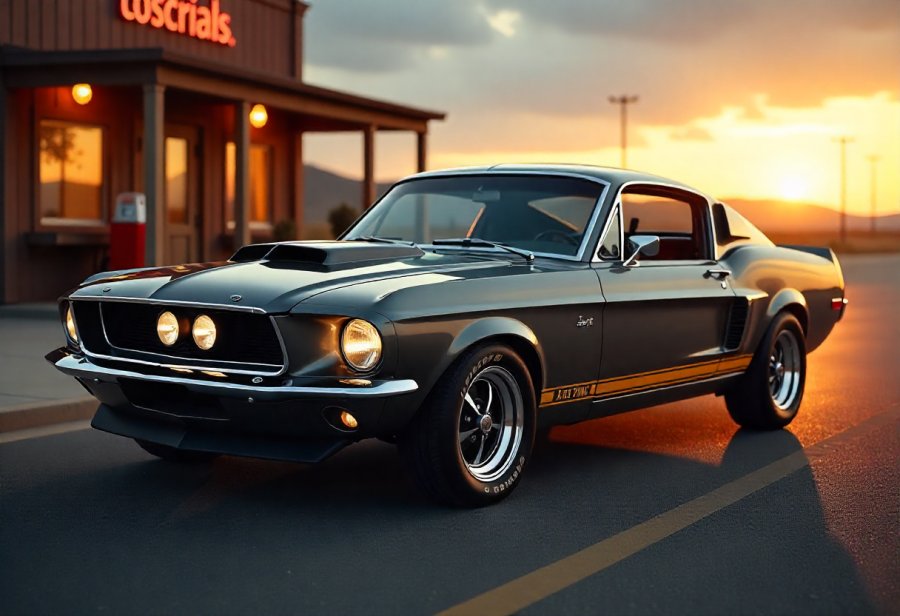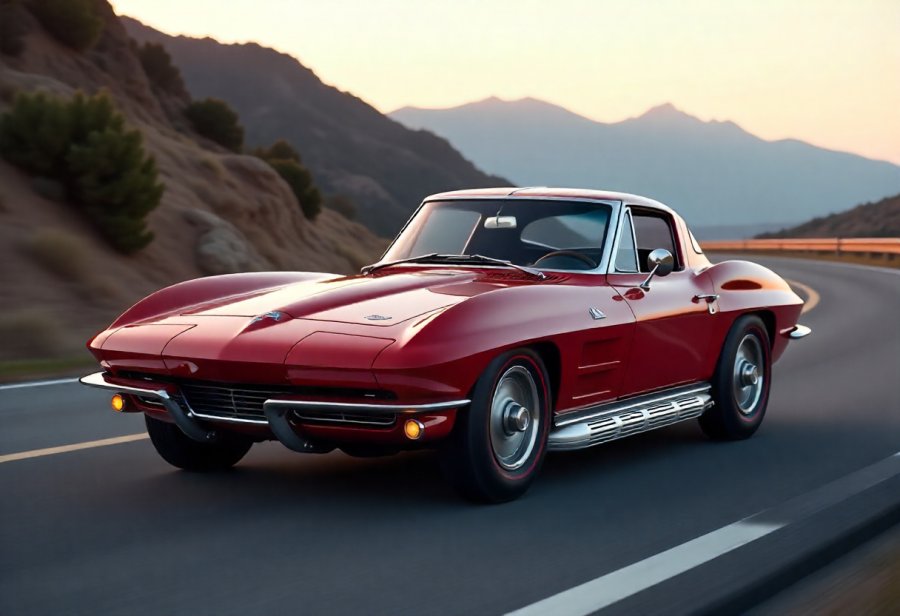The 1970s Chevrolet SS epitomizes the raw power, bold design, and rebellious spirit of America’s golden muscle car era. From its aggressive styling, high-performance 454 V8 engine, to its cultural significance, this car was more than transportation—it was a statement of freedom and individuality. Today, restored models and enthusiast communities keep its legacy alive, celebrating the craftsmanship and adrenaline-fueled adventure that defined the age. But as modern technology pushes toward sustainability, the challenge remains: can the heart-pounding roar and iconic attitude of muscle cars survive in an era of electric innovation? Will future models honor the rebellious ethos while embracing new advancements? The enduring allure of the Chevrolet SS suggests that, whether through preservation or reinterpretation, the spirit of American muscle cars endures, blending nostalgia with cutting-edge performance. How will this iconic culture evolve without losing its fierce, rebellious soul?

Unleashing American Power: The 1970s Chevrolet SS and the Muscle Car Revolution
The 1970s marked the peak of the muscle car era, a time when American automakers celebrated raw power, bold design, and rebellious attitude. Cars like the Chevrolet SS rose to symbolize this cultural shift, embodying a sense of freedom and adrenaline that defined a generation. These vehicles weren’t just transportation; they were statements—rolling icons of American ingenuity and independence. With their aggressive lines, wide stances, and standout features, muscle cars captured the imagination of enthusiasts and casual fans alike.
The Chevrolet SS became more than just a performance car; it was a cultural phenomenon. Its design combined muscle and style, with racing stripes, cowl-induction hoods, and chrome accents that announced its presence on the street. Beneath the striking exterior lay powerful engines, notably the legendary 454 cubic inch (7.4L) V8, which delivered up to 450 horsepower. This formidable power made the SS a true street monster, capable of turning heads and tearing up asphalt with ease.
This era was driven by a desire to push boundaries—both in performance and aesthetics. Automakers like Chevrolet responded by creating vehicles that looked as fierce as they performed, emphasizing stability at high speeds and aerodynamic styling. The muscle car was designed to thrill, with every detail crafted to deliver maximum excitement, from its muscular silhouette to its driver-centric interior controls. It wasn’t just about speed; it was about making an impression.
The muscle car boom also reflected broader societal trends—youthful rebellion, independence, and a love of adrenaline-fueled adventure. Movies, music, and pop culture cemented these cars as symbols of freedom, often depicted tearing through highways or showcased in iconic scenes. Chevrolet’s SS models became aspirational, blending accessibility with exclusivity, appealing to those who wanted to stand out and challenge norms.
In essence, the Chevrolet SS of the 1970s stands as a testament to America’s passion for performance and style. It’s a vivid reminder of an era where horsepower reigned supreme and cars were built to evoke emotion and excitement. Today, these vehicles remain symbols of a golden age, capturing the spirit of rebellion and craftsmanship that made muscle cars a lasting icon of American automotive history.
From Bold Origins to Market Dominance: The Development of the Chevrolet SS
The origins of the Chevrolet SS are rooted in General Motors’ drive to make a bold statement in the rapidly expanding muscle car market of the late 1960s and early 1970s. As competition among automakers intensified, Chevrolet sought to create a vehicle that combined aggressive styling with serious performance, aiming to stand out in a crowded field. The result was a lineup of cars that emphasized muscular bodies, wide stances, and high-powered engines, with the SS badge becoming synonymous with street-ready performance and style.
The design philosophy behind the Chevrolet SS focused on balancing form and function. Bold, muscular lines and a wide stance weren’t just for visual impact—they contributed to stability and aerodynamics at high speeds. Features like cowl-induction hoods weren’t merely aesthetic; they improved airflow to the engine, boosting performance. Inside, the cockpit was driver-focused, with controls designed for quick responses and a feeling of control, reinforcing the car’s performance intent. Every detail aimed to create a vehicle that looked as capable as it performed.
Market-wise, Chevrolet positioned the SS models as aspirational yet accessible performance cars. They appealed to enthusiasts eager for style and speed without the hefty price tag of European sports cars. These cars were designed to turn heads on the street and dominate in racing circles, especially drag strips. This dual appeal helped Chevrolet carve out a distinct niche in the muscle car segment, drawing in drivers hungry for excitement and individuality.
The rise of muscle cars like the Chevrolet SS reflected a broader cultural movement—one of rebellion, independence, and adrenaline-fueled adventure. These vehicles became symbols of freedom, often depicted tearing through highways or showcased in movies and music that celebrated American muscle. The legendary 454 cubic inch (7.4L) V8 engine, capable of producing up to 450 horsepower, became a defining feature, turning the SS into a true performance icon. Every element, from design to engineering, was aimed at capturing and embodying this rebellious spirit.
Throughout its development, Chevrolet relentlessly refined its approach, pushing the limits of performance and style. The combination of powerful engines, aggressive styling, and driver-centric features established the SS as more than just a car; it was a statement of American ingenuity and daring. This focus on innovation and bold design laid the foundation for the Chevrolet SS’s lasting legacy as a symbol of muscle car excellence and cultural significance.

Living Legend: The Chevrolet SS’s Enduring Legacy and Cultural Relevance Today
Today, the Chevrolet SS is celebrated as a true icon of American muscle car heritage. Restored models frequently take pride of place at vintage car shows and muscle car festivals, drawing admiration for their commanding presence and nostalgic appeal. The sound of their engines still turns heads, serving as a reminder of the golden era when American horsepower ruled the streets. For many enthusiasts, owning or simply appreciating a Chevrolet SS connects them to a pivotal chapter in automotive history—one defined by speed, style, and rebellious spirit.
The community surrounding these cars remains lively and passionate. Restorers and collectors invest significant time and resources into maintaining authenticity, often seeking original or high-quality reproduction parts. When meticulously restored, a Chevrolet SS not only looks impressive but also performs reliably, allowing owners to enjoy them on the road or show off at events. Car clubs, online forums, and social media groups foster a shared culture of appreciation, where stories, tips, and images keep the muscle car passion alive and thriving.
Despite the decades that have passed since their heyday, the allure of the Chevrolet SS endures. Its muscular lines, racing stripes, and aggressive stance still evoke nostalgia and admiration. Owners take pride in the car’s storied history, participating in local or national shows to celebrate its legacy. For many, these vehicles are more than just collectibles—they are personal tributes to an era when American muscle reigned supreme and cars symbolized freedom and rebellion.
Restoration projects play a crucial role in preserving this legacy. Enthusiasts dedicate months or even years to sourcing authentic parts and returning their cars to factory condition or enhancing performance. Showcasing these efforts at events highlights both individual craftsmanship and the collective history of muscle cars. Each restored Chevrolet SS becomes a moving artifact, embodying the spirit of the golden age of American horsepower and performance.
While modern regulations and environmental concerns pose challenges, the cultural significance of the Chevrolet SS remains strong. Many supporters advocate for new models that honor the styling and performance of the originals, sometimes exploring electric powertrains that aim to deliver similar excitement without the emissions. These efforts reflect a desire to keep the rebellious, performance-driven ethos alive, even as technology evolves.
The influence of the Chevrolet SS extends into contemporary automotive design, inspiring modern muscle-inspired models that emphasize bold aesthetics and performance. Car shows, custom builds, and enthusiast gatherings continue to celebrate the legacy, fostering a culture rooted in craftsmanship and individual expression. This vibrant community ensures that the spirit of the muscle car remains relevant and dynamic, blending history with innovation.
Ultimately, the Chevrolet SS’s enduring appeal lies in its ability to symbolize more than just speed—it embodies freedom, craftsmanship, and American ingenuity. Its legacy persists through restored classics and innovative reinterpretations, inspiring new generations to chase performance and style. As long as the roar of these cars echoes in the collective consciousness, the spirit of muscle cars will continue to thrive, celebrating a timeless rebellion against the ordinary.
For enthusiasts eager to experience the thrill firsthand, attending events or joining clubs dedicated to the Chevrolet SS can deepen their appreciation. Exploring the history and community surrounding these cars offers a richer connection to their legacy, and many find inspiration in resources like the Chevrolet SS restoration guide to help them maintain or recreate these iconic vehicles.
Muscle Car Inspiration: How Chevrolet SS Shapes Modern Design and Lifestyle
The influence of the Chevrolet SS and muscle car culture extends far beyond their original era, shaping modern automotive design and lifestyle in subtle yet powerful ways. Today’s manufacturers often draw inspiration from the bold lines, aggressive stances, and performance-focused details that defined classic muscle cars. Elements like wide bodies, racing stripes, and sleek profiles now serve as modern design cues, helping new vehicles evoke the same sense of power and rebellion that made their predecessors icons. This visual language continues to resonate with enthusiasts, blending nostalgia with contemporary innovation.
This legacy also fuels a vibrant community centered around car enthusiasm. Car shows, muscle car festivals, and custom build events serve as communal spaces where owners and fans celebrate American horsepower. Many participate in clubs or online forums, sharing tips on restoration, performance upgrades, and personalization. These activities foster a sense of camaraderie rooted in a shared passion for craftsmanship, speed, and individual expression. Whether it’s a meticulously restored classic or a modern reinterpretation, each vehicle embodies a lifestyle that values freedom and the thrill of the open road.
Restoring vintage Chevrolet SS models exemplifies how this passion endures. Enthusiasts dedicate time and resources to sourcing authentic parts and meticulously returning their cars to factory condition or enhancing their performance. The process often involves careful attention to every detail—paint, interior, engine—ensuring the vehicle remains true to its roots. Showcasing these restorations at events celebrates individual achievement and preserves the collective history of American muscle cars, keeping alive the rebellious spirit and craftsmanship that define the culture.
Maintaining these classics requires patience and a commitment to authenticity. Owners often invest months in sourcing original or high-quality reproduction parts and performing routine mechanical upkeep. Regular maintenance, tuning, and occasional upgrades allow these cars to remain reliable and enjoyable, whether for cruising or show. Sharing stories and advice within communities deepens the connection to the car’s history, turning ownership into a personal tribute to a golden age of performance and style.
Despite evolving regulations and environmental concerns, the muscle car ethos remains vibrant. Many enthusiasts support efforts to develop electric models that honor the styling and performance of the originals, blending tradition with innovation. These vehicles often feature bold aesthetics—wide stances, racing stripes, aggressive styling—adapted for today’s roads and standards. This ongoing evolution ensures that muscle cars continue to symbolize freedom, rebellion, and individualism, inspiring new generations to chase speed and style while respecting their roots.

Revving into Tomorrow: The Future of Muscle Cars and Technological Evolution
Looking ahead, the future of muscle cars blends the rebellious spirit of the past with cutting-edge technology. While the deep, unmistakable growl of a big-block V8 has long defined their identity, automakers are now reimagining muscle cars with electric powertrains that deliver instant torque and high performance without sacrificing that raw excitement. The challenge is to maintain the core appeal—power, attitude, and presence—while embracing sustainable innovations. Many brands are exploring electric models that feature bold styling, aggressive stances, and performance capabilities that honor the legacy of their gasoline-powered ancestors.
Design-wise, muscle cars of the future will continue to draw inspiration from their roots but with a modern twist. Expect wide, muscular bodies, prominent racing stripes, and aerodynamic details that emphasize speed and attitude. Some manufacturers are resurrecting iconic models as electric versions, paying homage to the past while pushing the boundaries of innovation. Digital dashboards, customizable driving modes, and adaptive suspensions will enhance the driving experience, offering a blend of nostalgia and modern convenience. This evolution aims to satisfy both traditional enthusiasts and newcomers eager for performance with a conscience.
The culture surrounding muscle cars is also shifting, yet the passion remains strong. Electric models that retain the performance ethos are gaining ground, supported by a community that values individual expression and high-performance craftsmanship. Car clubs, social media groups, and custom build events continue to foster camaraderie, sharing stories of restoration, modification, and personalization. These gatherings reflect a desire to preserve the rebellious attitude and thrill of the original muscle car era, even as the technology transforms.
However, hurdles lie ahead. Stricter emissions standards and environmental regulations push manufacturers to innovate faster. While electric powertrains promise a future with zero emissions, questions about authenticity and visceral experience linger. Will the signature sound and visceral torque of a V8 be replaced by engineered artificial noises? Many enthusiasts hope that new technologies—such as simulated engine sounds and performance upgrades—will keep the thrill alive, bridging the gap between tradition and progress. The goal is to deliver performance that excites without compromise.
The ultimate vision sees muscle cars evolving into high-performance icons that honor their rebellious roots while embracing sustainability. Electric models with bold styling, rapid acceleration, and customizable features will continue to captivate new generations. The core ideals of freedom, craftsmanship, and individualism will endure, inspiring innovation that respects history. As technology advances, muscle cars will remain symbols of adrenaline and independence, proving that their legendary roar can adapt and thrive in a changing world.







